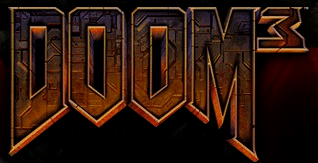August 03, 2004
Doom 3: Can Carmack's "id" Reinvent Computer Games (as it did with the original, Doom)?

id Software released the much-anticipated "Doom 3" first-person-shooter on the world this week, to largely rave reviews:
-
“Doom 3,” the newest entry in game developer id Software’s horror hall of fame, is a departure of sorts. You still have hordes of demons after you. And that familiar click-click of the reloading shotgun remains. But over time, things have changed.
With previous id games, from 1993’s original “Doom” through 1994’s “Doom II” and 1996’s “Quake,” you were rewarded for shooting first and worrying about the consequences later. Now -- though you again play a Marine on Mars, facing a horde of demons unleashed from hell by scientific experiments -- you have to be careful not to eradicate a character who might hold a valuable clue to the secret to preventing a demonic assault on Earth.
“The first game didn’t have much depth,” says technical director John Carmack, who co-founded id in 1991 and was made wealthy by “Doom.” “Early on, we were just excited to get the basics, to get people scared or shocked at all.”
The original was groundbreaking. It established the success of the software marketing system known as shareware: The game was available free to download, swap and try, and customers paid to unlock higher levels. Some 20 million wound up playing the game. Subsequent id software games such as “Doom II,” “Quake” and “Return to Castle Wolfenstein” have sold a collective 15 million.
“Every game they have produced has set the standard for that time,” says fan Matthew Wood, 20, of Merritt Island, Fla. Since id announced last month that “Doom 3” -- after several long delays -- was finished and getting ready to ship, “time slowed down for many of us,” Wood says. “I pre-ordered the next day. ... ’Doom 3’ looks scary as hell. I cannot wait.”
“Doom” also popularized the “first-person shooter” concept: Players view the 3-D world through the eyes of the character on screen, wielding weaponry as if it were in their own hands.
Anti-violence activists decry the genre. “Desensitization is the classic problem that comes from these games’ point of view,” says Roy Fox, chairman of the department of learning, teaching and curriculum at the University of Missouri. He worries that children and teens will get access to the game, which is rated M for mature players, ages 17 and older. “It breeds the acceptance of violence.”
The action in “Doom 3” promises to be more intense than its predecessors, with effects and environments reminiscent of such movies as “Alien,” thanks to Carmack’s breakthrough method of realistically tying lighting and textures of objects to the player’s movements. “On a cinematic level, there’s depth and story,” says Carmack, who has already begun work on the next id game, an original title. “I’m extremely excited at how it turned out.”
One of the most anticipated games in years, “Doom 3” will have to battle for Game of the Year honors with “Half-Life 2,” a sequel to Valve Software’s 1998 top game. “It’s kind of a parlor game to discuss which is the most anticipated of the two,” says Dan Morris, editor of PC Gamer.
Together, the games could amount to a renaissance for a PC industry desperate to reclaim some of the glamour from console video games, which have been responsible for the bulk of the $10 billion video-game market. “This is going to swing the pendulum back our way,” Morris says.
In the September issue, Morris gives “Doom 3” the magazine’s highest rating in recent times (94 percent). “Its biggest breakthrough, after the technological side, is that it’s a compelling story,” he says. “The main purpose is not to shock you out of your seat but to draw you into a world and into a drama.”
“Doom 3” not only looks like a scary movie, it was developed like one. For this game, id Software recruited Matt Costello, who penned the stories for classic plot-driven games “The Seventh Guest” and “The Eleventh Hour,” to flesh out a script from which artists created storyboards, just as filmmakers do. “It allowed us to put all the action into the context of the story,” says id CEO Todd Hollenshead. “The players, when they play through the game, they will know where they are, they will understand the environment and will have a sense of purpose. We felt that was important.”
More fun though was Slate.com's piece on the designers behind the games, in this case, profiling John Carmack - dean of FPS genre game design.
- Arik
Posted by Arik Johnson at August 3, 2004 09:48 AM | TrackBack "Competitive Intelligence applies the lessons of competition and principles of intelligence to the need for every business to gain awareness and predictability of market risk and opportunity. By doing so, CI has the power to transform an enterprise from also-ran into a real winner, with agility enough to create and maintain sustainable competitive advantage."
"Competitive Intelligence applies the lessons of competition and principles of intelligence to the need for every business to gain awareness and predictability of market risk and opportunity. By doing so, CI has the power to transform an enterprise from also-ran into a real winner, with agility enough to create and maintain sustainable competitive advantage."
